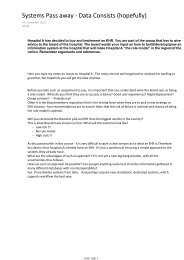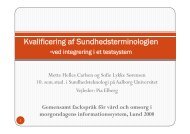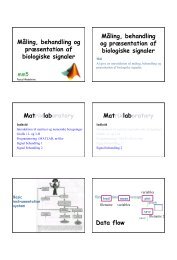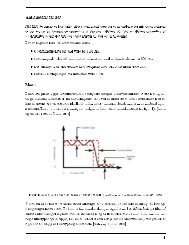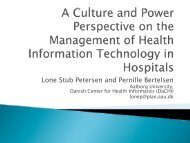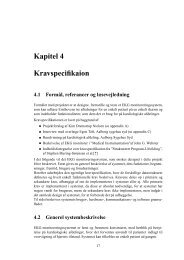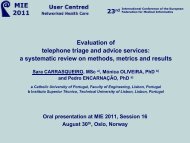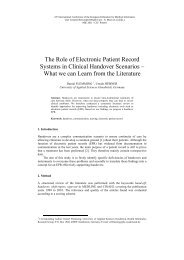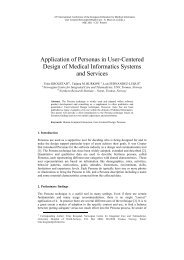Use of Grounded Theory in Health Informatics - Department of ...
Use of Grounded Theory in Health Informatics - Department of ...
Use of Grounded Theory in Health Informatics - Department of ...
You also want an ePaper? Increase the reach of your titles
YUMPU automatically turns print PDFs into web optimized ePapers that Google loves.
<strong>Use</strong> <strong>of</strong> <strong>Grounded</strong> <strong>Theory</strong> <strong>in</strong> <strong>Health</strong><br />
<strong>Informatics</strong><br />
Elizabeth BORYCKI a,1 , Craig KUZIEMSKY b , Elizabeth CUMMINGS c ,<br />
Pernille BERTELSEN d<br />
a School <strong>of</strong> <strong>Health</strong> Information Science, University <strong>of</strong> Victoria, British Columbia,<br />
Canada.<br />
b Telfer School <strong>of</strong> Management, University <strong>of</strong> Ottawa, Ottawa, Canada<br />
c. e<strong>Health</strong> Services Research Group, University <strong>of</strong> Tasmania, Hobart, Australia<br />
d <strong>Department</strong> <strong>of</strong> Development and Plann<strong>in</strong>g, Virtual Centre <strong>of</strong> <strong>Health</strong> <strong>Informatics</strong>,<br />
Aalborg University, Denmark,<br />
1. Introduction<br />
Abstract. The value <strong>of</strong> utilis<strong>in</strong>g qualitative research approaches to identify, describe<br />
and evaluate the impact <strong>of</strong> HISs upon healthcare processes is becom<strong>in</strong>g <strong>in</strong>creas<strong>in</strong>gly<br />
clear. The use <strong>of</strong> grounded theory (GT) as a research and evaluation<br />
methodology has <strong>in</strong>creased over the past decade with<strong>in</strong> the health <strong>in</strong>formatics discipl<strong>in</strong>e.<br />
However, for researchers new to the approach, the theory and conduct <strong>of</strong><br />
grounded theory can be both confus<strong>in</strong>g and daunt<strong>in</strong>g. One <strong>of</strong> the significant challenges<br />
with us<strong>in</strong>g GT <strong>in</strong> health <strong>in</strong>formatics research is that many studies have used<br />
variations <strong>of</strong> GT such as a ‘grounded theory guided’ or a ‘grounded approach’<br />
[1,2]. While these variations have extended the use <strong>of</strong> GT <strong>in</strong> health <strong>in</strong>formatics<br />
they have also added to the confusion as to when GT is an appropriate method and<br />
how it should be used.<br />
Keywords. <strong>Grounded</strong> theory, methodology, qualitative research, health <strong>in</strong>formatics<br />
A number <strong>of</strong> qualitative methods have been used effectively <strong>in</strong> health <strong>in</strong>formatics to<br />
design and develop health <strong>in</strong>formation systems (HIS) [1], and identify, describe and<br />
evaluate the impact <strong>of</strong> HISs on healthcare processes and outcomes [2]. These qualitative<br />
methods <strong>in</strong>clude ethnography, grounded theory, and case study research.<br />
<strong>Grounded</strong> theory (GT), as a qualitative approach, has demonstrated utility when applied<br />
to systems design and development as well as evaluation <strong>in</strong> terms <strong>of</strong> the impacts<br />
<strong>of</strong> HIS upon healthcare. Methodologically, GT’s use <strong>in</strong> health <strong>in</strong>formatics has evolved<br />
s<strong>in</strong>ce its first <strong>in</strong>troduction to this discipl<strong>in</strong>e <strong>in</strong> the early 1990’s (e.g. [3,4]). Its frequency<br />
<strong>of</strong> use <strong>in</strong> health <strong>in</strong>formatics has grown, as researchers have applied the methodology<br />
and used it to <strong>in</strong>form systems design and evaluation work [4]. Although GT’s use has<br />
grown <strong>in</strong> popularity, many researchers and health <strong>in</strong>formatics pr<strong>of</strong>essionals are unfamiliar<br />
with the methodology <strong>in</strong> terms <strong>of</strong> its application and use <strong>in</strong> <strong>in</strong>form<strong>in</strong>g HIS design,<br />
development and evaluation. The purpose <strong>of</strong> this workshop will be to provide<br />
researchers with an opportunity to learn about GT as a methodology to the design, de-<br />
1 Correspond<strong>in</strong>g Author<br />
23 rd International Conference <strong>of</strong> the European Federation for Medical <strong>Informatics</strong><br />
<strong>Use</strong>r Centred Networked <strong>Health</strong> Care - A. Moen et al. (Eds.)<br />
MIE 2011 / CD / Workshops
velopment and evaluation <strong>of</strong> HIS. The workshop will provide participants with the opportunity<br />
to explore the fundamentals <strong>of</strong> grounded theory and then apply the methodology<br />
us<strong>in</strong>g a hands-on approach.<br />
2. Goal <strong>of</strong> the Workshop<br />
The workshop will provide researchers and health <strong>in</strong>formatics pr<strong>of</strong>essionals with an<br />
opportunity to learn about grounded theory as a methodology for HIS design, development<br />
and evaluation through lectures and a hands-on experience <strong>in</strong> us<strong>in</strong>g the methodology<br />
<strong>in</strong> a supported group environment. The workshop leaders will draw on uses <strong>of</strong><br />
GT to provide <strong>in</strong>sight to different ways GT can be used <strong>in</strong> health <strong>in</strong>formatics studies.<br />
3. Objectives<br />
The objectives <strong>of</strong> the workshop are as follows:<br />
1. To outl<strong>in</strong>e the historical development <strong>of</strong> GT as a methodology, <strong>in</strong>clud<strong>in</strong>g how GT<br />
was first <strong>in</strong>troduced <strong>in</strong>to HIS research and later <strong>in</strong>to health <strong>in</strong>formatics.<br />
2. To provide an overview <strong>of</strong> its current uses with examples from real-world projects,<br />
<strong>in</strong>clud<strong>in</strong>g the use <strong>of</strong> s<strong>of</strong>tware tools such as NVivo and Atlas.<br />
3. To provide an overview <strong>of</strong> the typical design <strong>of</strong> a GT study<br />
4. To provide participants with an opportunity to sketch out a grounded theory<br />
4. Format <strong>of</strong> the Workshop<br />
The workshop will be comprised <strong>of</strong> lectures when the underly<strong>in</strong>g theory and history <strong>of</strong><br />
grounded theory will be described as well as hands-on exercises that will allow participants<br />
to learn about how to design a GT study, analyse data us<strong>in</strong>g grounded theory approaches<br />
and present grounded theory data. Real world examples will be employed.<br />
4.1. Involved Speakers<br />
The workshop will be lead by researchers who have employed grounded theory:<br />
Dr. Elizabeth Borycki teaches Research Methods <strong>in</strong> the health <strong>in</strong>formatics graduate<br />
program at University <strong>of</strong> Victoria and has experience <strong>in</strong> the use <strong>of</strong> GT for evaluation <strong>of</strong><br />
HIS. Elizabeth will provide the historical background and discuss general use <strong>of</strong> GT.<br />
Dr Craig Kuziemsky has expertise <strong>in</strong> the use <strong>of</strong> GT to develop ontologies for HIS design.<br />
Craig will present about the use <strong>of</strong> GT for gather<strong>in</strong>g requirements to <strong>in</strong>form model<strong>in</strong>g<br />
and HIS design.<br />
Dr Elizabeth Cumm<strong>in</strong>gs has experience <strong>in</strong> us<strong>in</strong>g GT <strong>in</strong> evaluation <strong>of</strong> HIS at multiple<br />
levels and will present about the use <strong>of</strong> GT for HIS evaluation from experiences.<br />
Dr. Pernille Bertelsen has experience <strong>in</strong> the use <strong>of</strong> GT and <strong>in</strong> conduct<strong>in</strong>g <strong>in</strong>teractive<br />
workshops. Pernille will facilitate the <strong>in</strong>teractive portions <strong>of</strong> the workshop.
4.2. Subject Doma<strong>in</strong> to be Discussed<br />
The term ‘theory’ adds to the <strong>in</strong>trigue <strong>of</strong> this method as it raises the question do all GT<br />
studies actually need to produce a theory? Or can GT merely be used as an approach to<br />
analyse qualitative data? Perhaps more important is the question ‘is a theory always a<br />
necessary outcome from us<strong>in</strong>g GT, or is theory based GT more relevant to the social<br />
sciences where GT first emerged’? Although a classic tenet <strong>of</strong> GT is data analysis<br />
without any conceptual biases we are see<strong>in</strong>g more health <strong>in</strong>formatics studies us<strong>in</strong>g supplementary<br />
theories to provide granularity to the data analysis. GT is void <strong>of</strong> any specific<br />
theoretical underp<strong>in</strong>n<strong>in</strong>g and some researchers argue that our understand<strong>in</strong>g <strong>of</strong><br />
healthcare should <strong>in</strong>corporate exist<strong>in</strong>g theories where appropriate. For example, Reddy<br />
et al. used socio-technical theory to make GT analysis more mean<strong>in</strong>gful by draw<strong>in</strong>g out<br />
relationships between social and technical features <strong>of</strong> <strong>in</strong>ter-team coord<strong>in</strong>ation [5].<br />
A challenge observed <strong>in</strong> studies that purport to use GT is that they frequently do<br />
not provide illustrations <strong>of</strong> how GT was used such as provid<strong>in</strong>g examples <strong>of</strong> coded data.<br />
Although GT becomes a means <strong>of</strong> implied rigor for research studies there are few examples<br />
that actually show details <strong>of</strong> methodological rigor. It is common for studies <strong>in</strong><br />
healthcare to state they used a ‘grounded theory approach’ yet they <strong>of</strong>fer no methodological<br />
<strong>in</strong>sight as to how the data was coded to <strong>in</strong>form the results. The use <strong>of</strong> GT <strong>in</strong><br />
these papers is unfortunate as they do little to further the use <strong>of</strong> GT as a health <strong>in</strong>formatics<br />
method and <strong>in</strong> fact may imply that us<strong>in</strong>g GT is easier than it actually is.<br />
5. Expected Achievements and Outcomes<br />
Follow<strong>in</strong>g completion <strong>of</strong> this workshop, the participants will have an understand<strong>in</strong>g <strong>of</strong><br />
GT to identify applications <strong>of</strong> the methodology. The participants will be able to: (1)<br />
design a grounded theory study, (2) be able to analyse data collected us<strong>in</strong>g grounded<br />
theory approaches, (3) present this data, and (4) <strong>in</strong>corporate the f<strong>in</strong>d<strong>in</strong>gs <strong>in</strong>to HIS design<br />
and development work as well as use the <strong>in</strong>formation gathered from the study to<br />
<strong>in</strong>form future health <strong>in</strong>formation systems improvements.<br />
Statement <strong>of</strong> Participation: All <strong>of</strong> the workshop speakers are committed to participat<strong>in</strong>g <strong>in</strong> the<br />
conference.<br />
References<br />
[1] Kuziemsky, C.E., Down<strong>in</strong>g, G.M., Black, F.M., Lau, F. A <strong>Grounded</strong> <strong>Theory</strong> Guided Approach to Palliative<br />
Care Systems Design. International Journal <strong>of</strong> Medical <strong>Informatics</strong> 76S (2007),S141–S148<br />
[2] Ash, J.S., Gorman, P.N., Lavelle, M., Stavri, P.Z., Lyman, J., Fournier, L., Carpenter, J. Perceptions <strong>of</strong><br />
Physician Order Entry: Results <strong>of</strong> a Cross-Site Qualitative Study. Methods Inf Med 42 (2003), 313–23<br />
[3] Mead, G.H., M<strong>in</strong>d, self, and society. The University <strong>of</strong> Chicago Press, Chicago, 1934.<br />
[4] Cumm<strong>in</strong>gs, E., Borycki. E., <strong>Grounded</strong> theory evolution and its application <strong>in</strong> health <strong>in</strong>formatics. Studies<br />
<strong>in</strong> <strong>Health</strong> Technology and <strong>Informatics</strong> 164 (2011), 286-92<br />
[5] Reddy, M.C., Paul, S.A., Abraham, J., McNeese, M., DeFlitch, C., Yen. J. Challenges to effective crisis<br />
management: Us<strong>in</strong>g <strong>in</strong>formation and communication technologies to coord<strong>in</strong>ate emergency medical<br />
services and emergency department teams International Journal <strong>of</strong> Medical <strong>Informatics</strong> 78(4)<br />
(2009), 259-269.







